PHYDYAS 06/2010
1
M.Bellanger
on behalf of the participants:
CNAM: M.Bellanger, D.LeRuyet, D.Roviras, M.Terré
TUM: J.Nossek, L.Baltar, Q.Bai, D.Waldhauser
TUT: M.Renfors, T.Ihalainen, A.Viholainen, T.H.Stitz
UCL: J.Louveaux, A.Ikhlef
SINTEF: V.Ringset, H.Rustad
CTTC: M.Najar, C.Bader, M.Payaro
RA-CTI: D. Katselis, E. Kofidis, L. Merakos, A. Merentitis, N. Passas,
A. Rontogiannis, S. Theodoridis, D. Triantafyllopoulou, D. Tsolkas, D. Xenakis
UNINA: M.Tanda, T.Fusco
CEA-LETI: M.Huchard
AGILENT : J.Vandermot
ALCATEL-LUCENT/UK : A.Kuzminskiy
ALCATEL-LUCENT/DE : F.Schaich
COMSIS : P.Leclair, A.Zhao
FBMC physical layer : a primer
Summary:
The filter bank multicarrier (FBMC) transmission technique leads to an enhanced physical
layer for conventional communication networks and it is an enabling technology for the new
concepts and, particularly, cognitive radio.
The objective of this document is to provide an overview of FBMC, with emphasis on the
features which impact communication networks. The only prerequisite for reading the
document is basic knowledge in digital signal processing, in particular sampling theory, fast
Fourier transform (FFT) and finite impulse response (FIR) filtering. More thorough
developments on the techniques described, as well as alternative and more sophisticated
methods, are available on the website http://www.ict-phydyas.org .
The presentation begins with
to multicarrier
communications, pointing out the limitations of this simplistic approach, and, particularly, the
spectrum leakage. Then, it is shown that the FFT approach can evolve to a filter bank
approach which is straightforward to design and implement. For each block of data, the time
window is extended beyond the multicarrier symbol period and the symbols overlap in the
time domain. This time overlapping is at the basis of conventional efficient single carrier
modems where interference between the symbols is avoided if the channel filter satisfies the
Nyquist criterion. This fundamental principle
to multicarrier
transmission. Regarding implementation, the filter bank approach is just an extension of the
direct FFT approach and it can be realized with an extended FFT. An alternative scheme,
the direct application of
the FFT
is readily applicable
1
�
PHYDYAS 06/2010
2
requiring less computations, is the so-called polyphase network (PPN)-FFT technique, which
keeps the size of the FFT but adds a set of digital filters.
Contrary to OFDM (orthogonal frequency division multiplexing) where orthogonality must be
ensured for all the carriers, FBMC requires orthogonality for the neighbouring sub-channels
only. In fact, OFDM exploits a given frequency bandwidth with a number of carriers, while
FBMC divides the transmission channel associated with this given bandwidth into a number
of sub-channels. In order to fully exploit the channel bandwidth, the modulation in the sub-
channels must adapt to the neighbour orthogonality constraint and offset quadrature
amplitude modulation (OQAM) is used to that purpose. The combination of filter banks with
OQAM modulation leads to the maximum bit rate, without the need for a guard time or cyclic
prefix as in OFDM.
The effects of the transmission channel are compensated at the sub-channel level. The sub-
channel equalizer can cope with carrier frequency offset, timing offset and phase and
amplitude distortions, so that asynchronous users can be accomodated. When FBMC is
employed in burst transmission, the length of the burst is extended to allow for initial and
final transitions due to the filter impulse response. These transitions may be shortened if some
temporary frequency leakage is allowed, for example whenever a frequency gap is present
between neighbouring users. As a multicarrier scheme, FBMC can benefit from multiantenna
systems and MIMO techniques can be applied. Due to OQAM modulation, adaptations are
necessary for some MIMO approaches, in the diversity context.
FBMC systems are likely to coexist with OFDM systems. Since FBMC is an evolution of
OFDM, some compatibility can be expected. In fact, the initialization phase can be common
to both and efficient dual mode implementation can be realized.
In the multiuser context, the sub-channels or groups of sub-channels allocated to the users are
spectrally separated as soon as an empty sub-channel is present in-between. Therefore, users
do not need to be synchronized before they gain access to the transmission system. This is a
crucial facility for uplink in base station ruled networks or for future opportunistic
communications. In cognitive radio, the FBMC technique offers the possibility to carry out
the functions of spectrum sensing and transmission with the same device, jointly and
simultaneously. Moreover, the users enjoy a guaranteed level of spectral protection.
2
�
PHYDYAS 06/2010
3
Contents:
Summary
1) The FFT as a multicarrier modulator
2) Filtering effect of the FFT
3) Prototype filter design - Nyquist criterion
4) Extending the FFT to implement the filter bank
5) PPN-FFT to reduce computational complexity
6) OQAM modulation
7) Effects of the transmission channel
8) Sub-channel equalization
9) Burst transmission with FBMC
10) MIMO-FBMC
11) Compatibility with OFDM
12) FBMC in networks
Phydyas website
3
�
PHYDYAS 06/2010
4
P
/
S
di(mM)
iFFT
1. The FFT as a multicarrier modulator
The inverse fast Fourier transform (iFFT) can serve as a multicarrier modulator and the fast
Fourier transform (FFT) can serve as a multicarrier demodulator. A multicarrier transmission
system is obtained and the transmitter and the receiver are shown in Fig.1.
Fig.1. Multicarrier modulation with the FFT
It is obvious from the figure that the block of data at the input of the iFFT in the transmitter is
recovered at the output of the FFT in the receiver, since the FFT and the iFFT are cascaded.
The detailed description of the operations is as follows.
The size of the iFFT and the FFT is M and a set of M data samples,
0
by
with
the iFFT output is expressed
, is fed to the iFFT input. For
FFT
di((m-1)M)
transmitter
Mmn
( +
receiver
(mMdi
≤≤ Mi
x(n)
S
/
P
<≤
mM
)1
−
1
)
x n
( )
d mM e π
(
)
2
j
i
i n mM
(
−
M
)
M
1
−
= ∑
i
=
0
The set of M samples so obtained is called a multicarrier symbol and m is the symbol index.
For transmission in the channel, a parallel-to-serial (P/S) converter is introduced at the output
x n appear in serial form. The sampling frequency of the
of the iFFT and the samples
( )
transmitted signal is unity, there are M carriers and the carrier frequency spacing is 1/M. The
duration of a multicarrier symbol T is the inverse of the carrier spacing, T=M. Note that T is
also the multicarrier symbol period, which reflects the fact that successive multicarrier
symbols do not overlap in the time domain.
x n is a
( )
An illustration is given in Fig.2 for
2
is transmitted by i
i = periods. Similarly,
sine wave and the duration T contains
periods of a sine wave in the duration T . Overall, the transmitted signal is a collection of sine
waves such that the symbol duration contains an integer number of periods. In fact, it is the
condition for data recovery, the so-called orthogonality condition.
At the receive side, a serial-to-parallel (S/P) converter is introduced at the input of the FFT.
The data samples are recovered by
. The transmitted signal
i = and
2
mMd
(2
(mMdi
±=
1
)
)
mMd
i
(
)
=
1
M
mM
1
+
M
∑ −
mMn
=
−
j
enx
)(
2
π
mMni
(
−
M
)
Note also in Fig.1 that, due to the cascade of P/S and S/P converters, there is a delay of one
multicarrier symbol at the FFT output with respect to the iFFT input.
4
�
PHYDYAS 06/2010
5
T
A
+1
-1
d2(mM)
Real(x(n))
Fig.2. Data and transmitted signals
For the proper functioning of the system, the receiver (FFT) must be perfectly aligned in time
with the transmitter (iFFT). Now, in the presence of a channel with multipath propagation,
due to the channel impulse response, the multicarrier symbols overlap at the receiver input
and it is no more possible to demodulate with just the FFT, because intersymbol interference
has been introduced and the orthogonality property of the carriers has been lost.
Then, there are 2 options:
d2((m-1)M)
time
1) extend the symbol duration by a guard time exceeding the length of the channel
impulse response and still demodulate with the same FFT. The scheme is called
OFDM.
2) keep the timing and the symbol duration as they are, but add some processing to the
FFT. The scheme is called FBMC, because this additional processing and the FFT
together constitute a bank of filters.
The present document is concerned with this second approach and, as an introduction, it will
first be shown that the FFT itself is a filter bank.
2. Filtering effect of the FFT
Let us assume that the FFT is running at the rate of the serially transmitted samples.
Considering Fig.1, the relationship between the input of the FFT and the output with index
0=k
is the following
x n M
[ (
x n
(
1)]
....
=
−
+
+
−
=
)
)
y n
( )
0
1
M
M =
i
1
−∑
x n i
(
1
M
This is the equation of a low-pass linear phase FIR filter with the M coefficients equal to
M/1
. Disregarding the constant delay, the frequency response is
=
I
(
)
f
sin
M
π
sin
fM
f
π
It is shown in Fig.3, where the unit on the frequency axis is 1/M.
In the same conditions, the FFT output with index k is expressed by
x n M i e
(
)
ki M
2
π
=
−
+
1
−
M
−
j
/
y n
( )
k
1
M
∑
i
=
0
5
�
PHYDYAS 06/2010
6
4
/
Changing variables and replacing i by M i− , an alternative expression is
x n i e
(
)
ki M
2
π
=
M
j
/
y n
( )
k
1
M
−∑
i
1
=
1
0
0
1
2
-3
-2
-1
-4
1 . 2
0 . 8
0 . 6
0 . 4
0 . 2
-0 . 2
-0 . 4
ki M
I(f)
e π
j
2
A m p li tu d e
3
F re q u e n c y
Fig.3. FFT filter frequency response and coefficients in the frequency domain
The filter coefficients are multiplied by
, which corresponds to a shift in frequency by
of the frequency response. When all the FFT outputs are considered, a bank of M filters
Mk /
is obtained, as shown in Fig.4, in which the unit on the frequency axis is M/1
, the sub-carrier
spacing. The orthogonality condition appears through the zero crossings: at the frequencies
which are integer multiples of M/1
Fig.4. The FFT filter bank (frequency unit: sub-carrier spacing)
An FIR filter can be defined by coefficients in the time domain or by coefficients in the
frequency domain. The two sets of coefficients are equivalent and related by the discrete
Fourier transform (DFT). Returning to the first filter in the bank, the DFT of its impulse
response consists of a single pulse, as shown in Fig.3. In fact, the frequency coefficients are
, only one filter frequency response is non-zero.
10
12
Frequency
Amplitude
-0.2
0.2
0.4
1
0.8
0.6
0
2
4
6
8
0
6
�
PHYDYAS 06/2010
7
f
I
f
)
(
)
(
I
, which, according to the sampling theory, is
the samples of the frequency response
derived from them through the interpolation formula.
In the terminology of filter banks, the first filter in the bank, the filter associated with the zero
frequency carrier, is called the prototype filter, because the other filters are deduced from it
through frequency shifts. It is clearly apparent in Fig.4 that
is the frequency response of
a prototype filter with limited performance, particularly out-of-band attenuation. In order to
reduce the out-of-band ripples, it is necessary to increase the number of coefficients in the
time domain and, equivalently, in the frequency domain. Then, in the time domain, the filter
impulse response length exceeds the multicarrier symbol period T . In the frequency domain,
additional coefficients are inserted between the existing coefficients, allowing for a better
control of the filter frequency response.
Prototype filters are characterised by the overlapping factor K, which is the ratio of the filter
impulse response duration Θ to the multicarrier symbol period T . The factor K is also the
number of multicarrier symbols which overlap in the time domain. Generally, K is an integer
number and, in the frequency domain, it is the number of frequency coefficients which are
introduced between the FFT filter coefficients.
Now, the question is how to design the prototype filter and transmit data in such a manner
that no intersymbol interference occurs, in spite of the overlapping.
3. Prototype filter design – Nyquist criterion
Digital transmission is based on the Nyquist theory: the impulse response of the transmission
filter must cross the zero axis at all the integer multiples of the symbol period. The condition
translates in the frequency domain by the symmetry condition about the cut-off frequency,
which is half the symbol rate. Then, a straightforward method to design a Nyquist filter is to
consider the frequency coefficients and impose the symmetry condition.
In transmission systems, the global Nyquist filter is generally split into two parts, a half-
Nyquist filter in the transmitter and a half-Nyquist filter in the receiver. Then, the symmetry
condition is satisfied by the squares of the frequency coefficients. The frequency coefficients
of the half-Nyquist filter obtained for K=2,3 and 4 are given in Table1.
K
2
3
4
H0
1
1
1
H1
2/2
0.911438
0.971960
H2
-
0.411438
2/2
H3
-
-
0.235147
σ2 (dB)
-35
-44
-65
Table 1. Frequency domain prototype filter coefficients
In the frequency domain, the filter response consists of 2K-1 pulses, as shown in Fig.5 for
K=4. The continuous frequency response, also shown in Fig.5, is obtained from the frequency
coefficients through the interpolation formula for sampled signals which yields
fH
(
)
1
K
= ∑−
k
−=
(
K
H
)1
−
sin(
(
π
f
−
k
MK
sin(
(
π
k
MK
f
−
)
))
)
MK
k
MK
The out-of-band ripples have nearly disappeared and a highly selective filter has been
obtained.
7
�
PHYDYAS 06/2010
8
1
0.8
0.6
0.4
A m p litud e
Fig.5. Prototype filter frequency coefficients and frequency response for K=4.
The impulse response
frequency response, which is
th
21)(
F re q ue ncy
cos(
+=
H (f)
)(th
2
π
-0.5
-1.5
0.2
0.5
1.5
H
-2
-1
)
0
1
2
0
1
K
∑−
k
of the filter is given by the inverse Fourier transform of the pulse
kt
KT
k
1
=
5
4
3
2
K = 4
Amplitude
It is shown in fig.6 for the filter length L=1024, the number of sub-channels M=256 and K=4.
Fig.6. Impulse response of the prototype filter for overlapping factor K=4.
Once the prototype filter has been designed, the filter bank is obtained by the frequency shifts
/k M , as in the FFT case. The filter with index k is obtained by multiplying the prototype
filter coefficients by
, as mentioned in section 2 for the FFT. A section of the filter
bank derived in that manner is shown in Fig.7. The sub-channel index corresponds to the
900
Time
e π
j
2
ki M
1000
500
600
800
100
200
300
400
700
-1
1
0
0
/
8
�
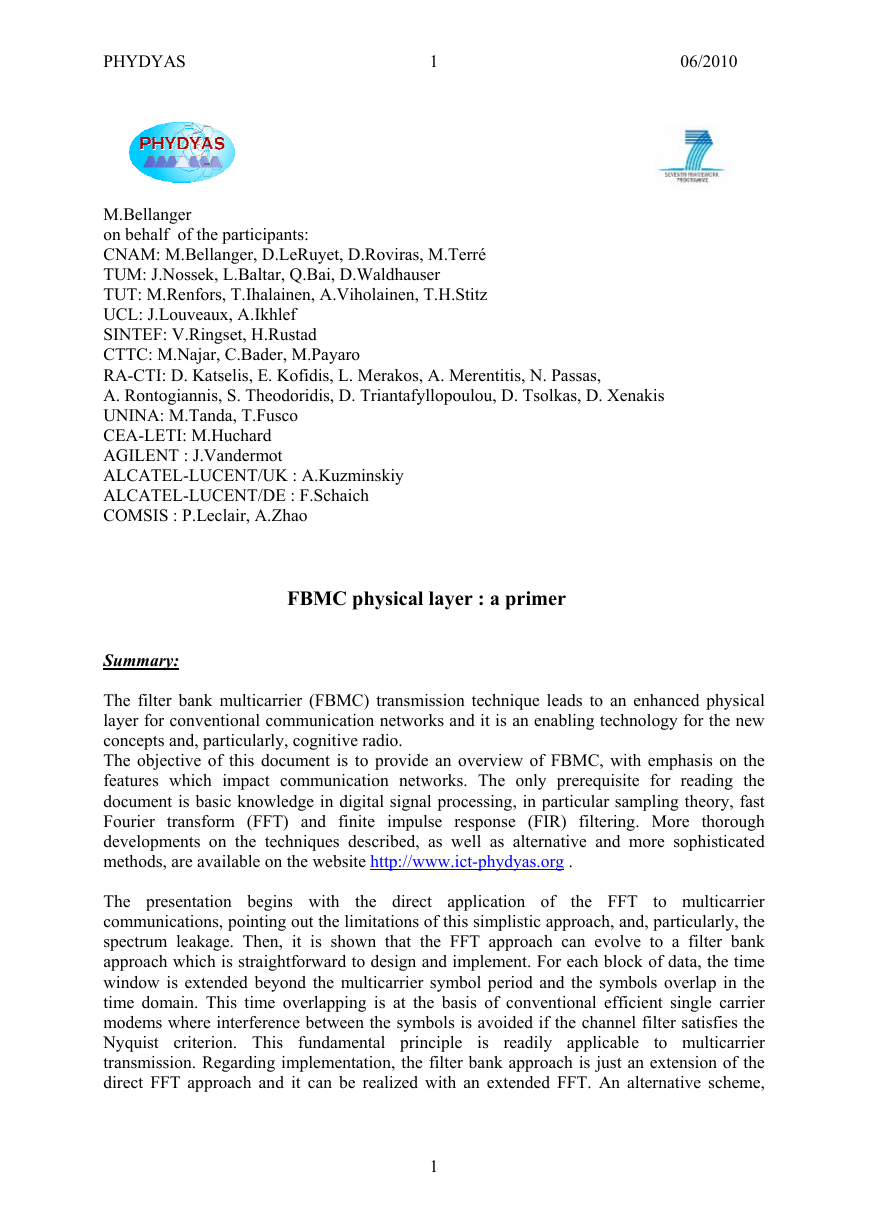
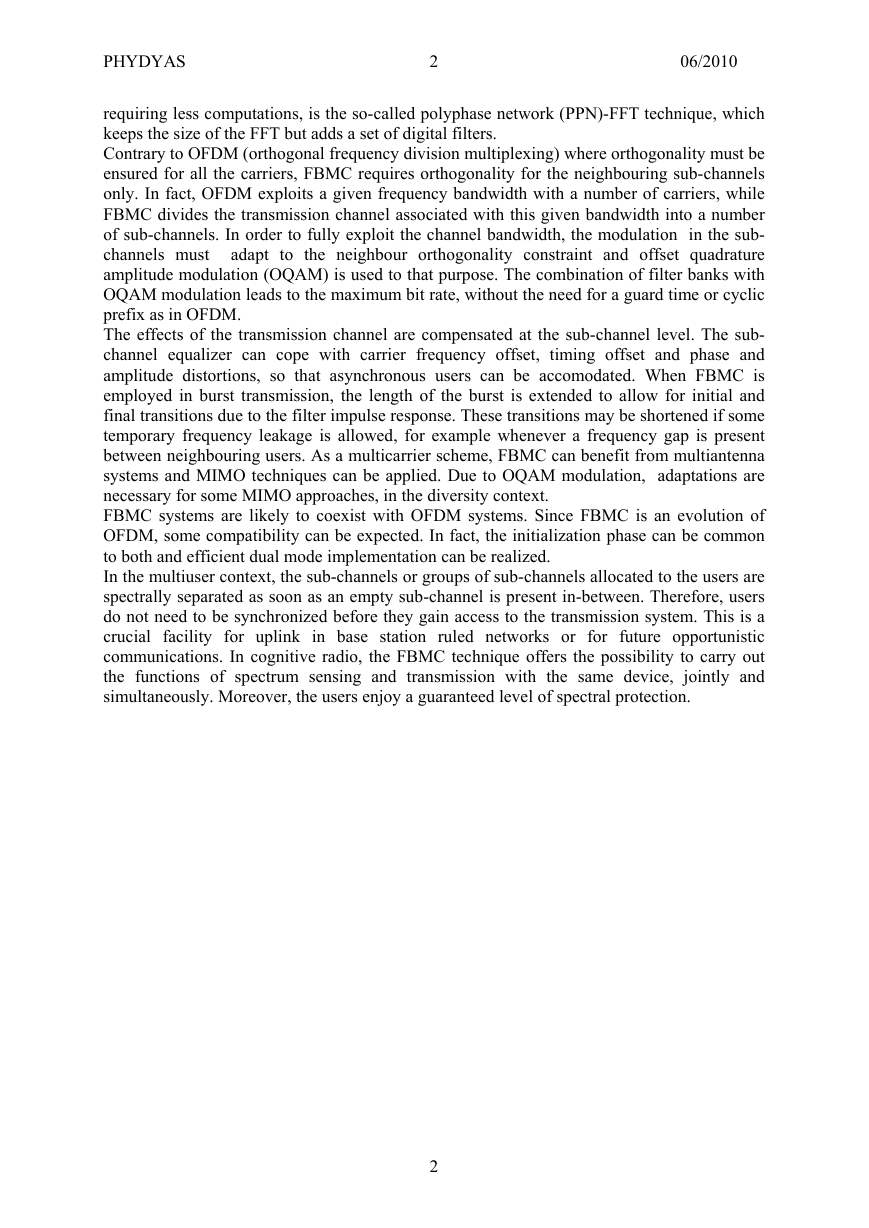
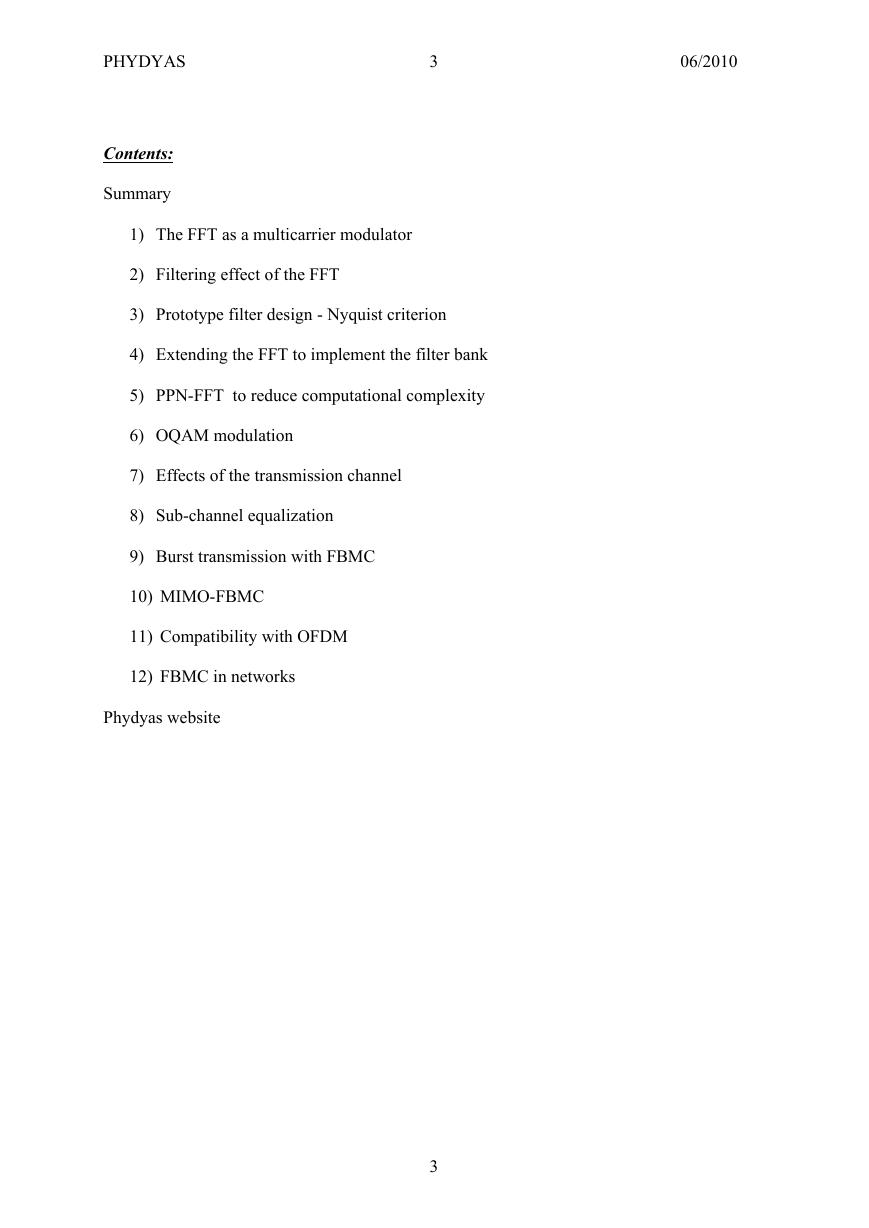
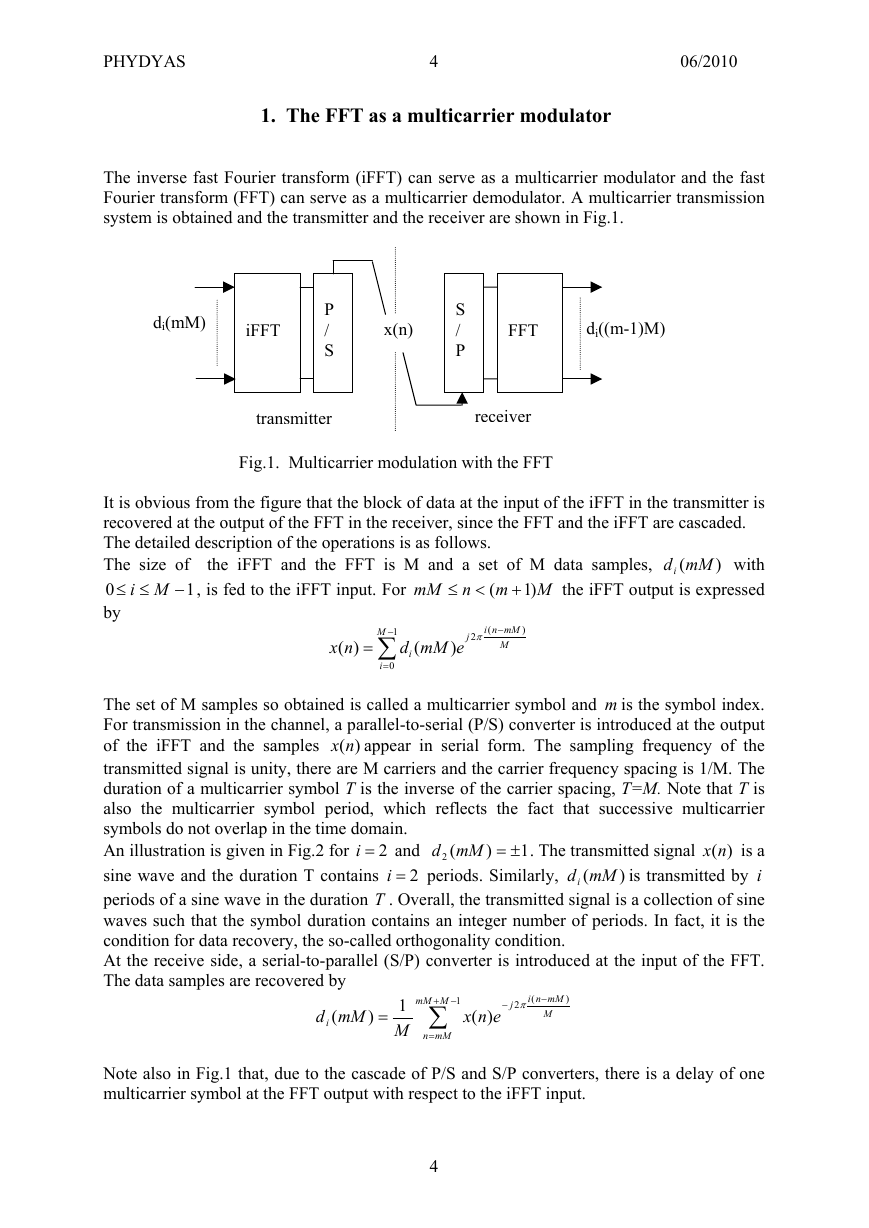
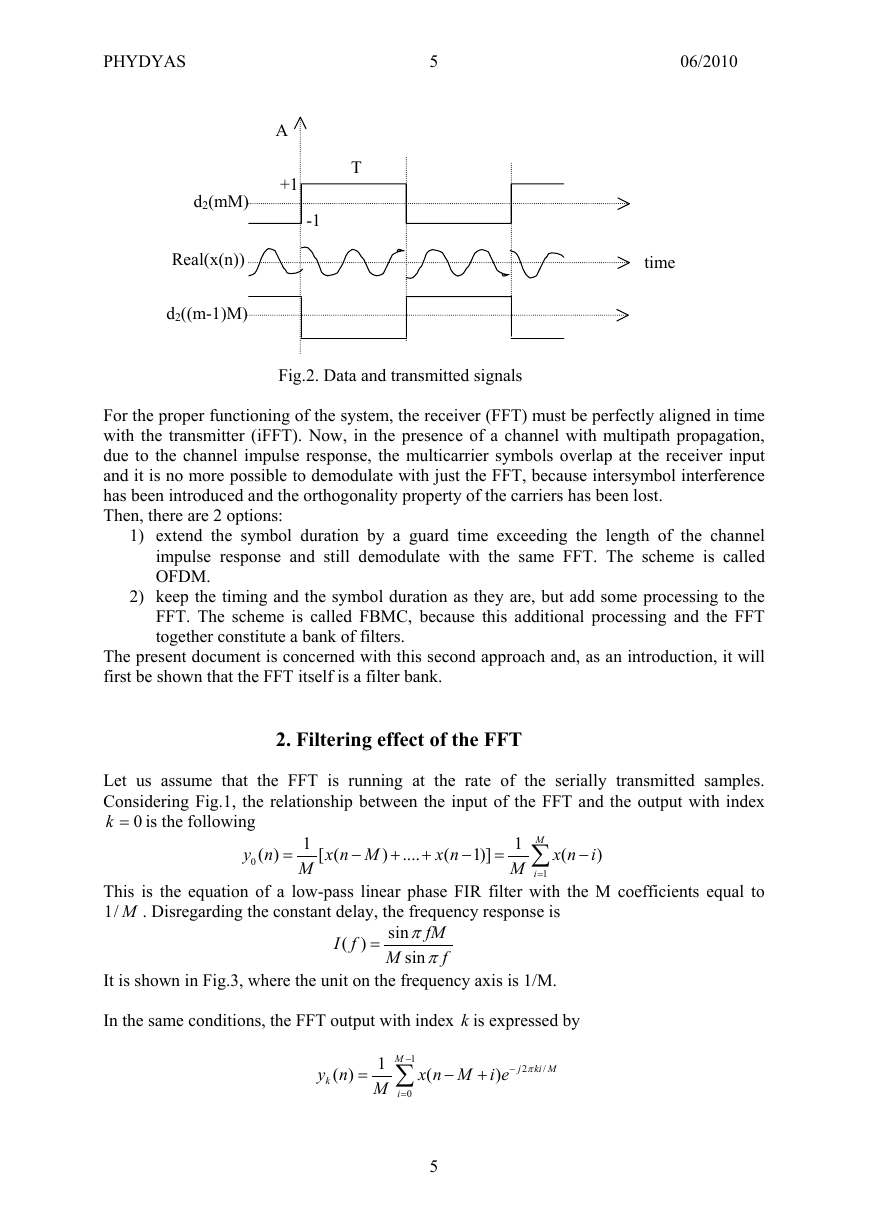
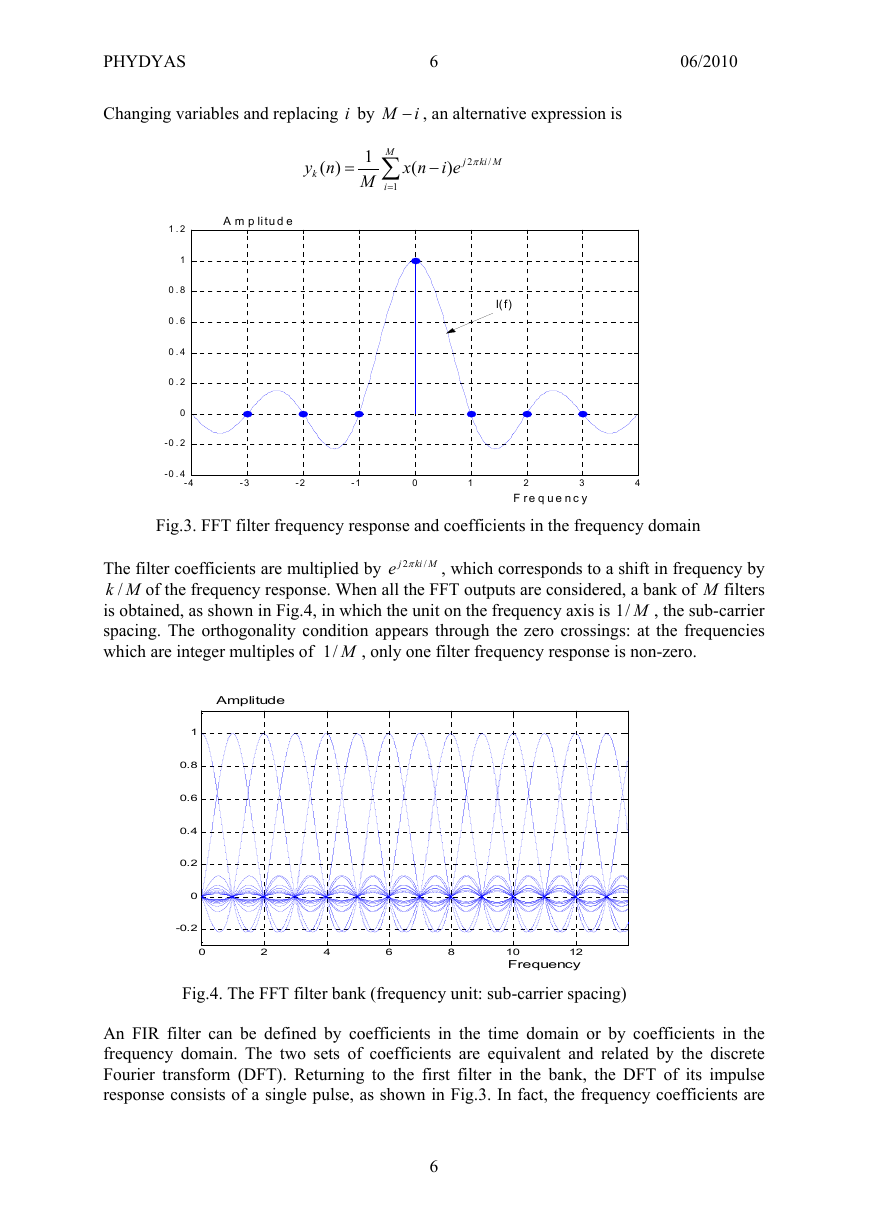
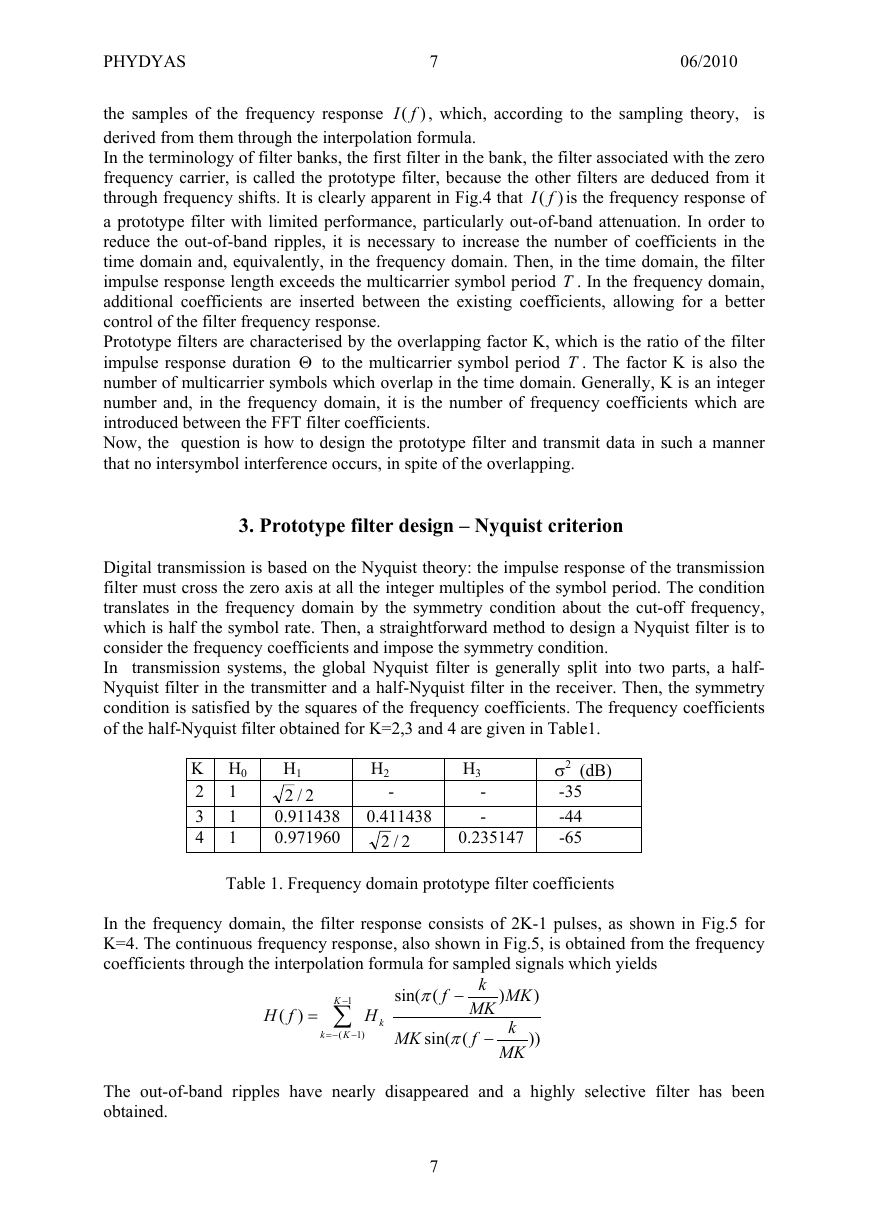
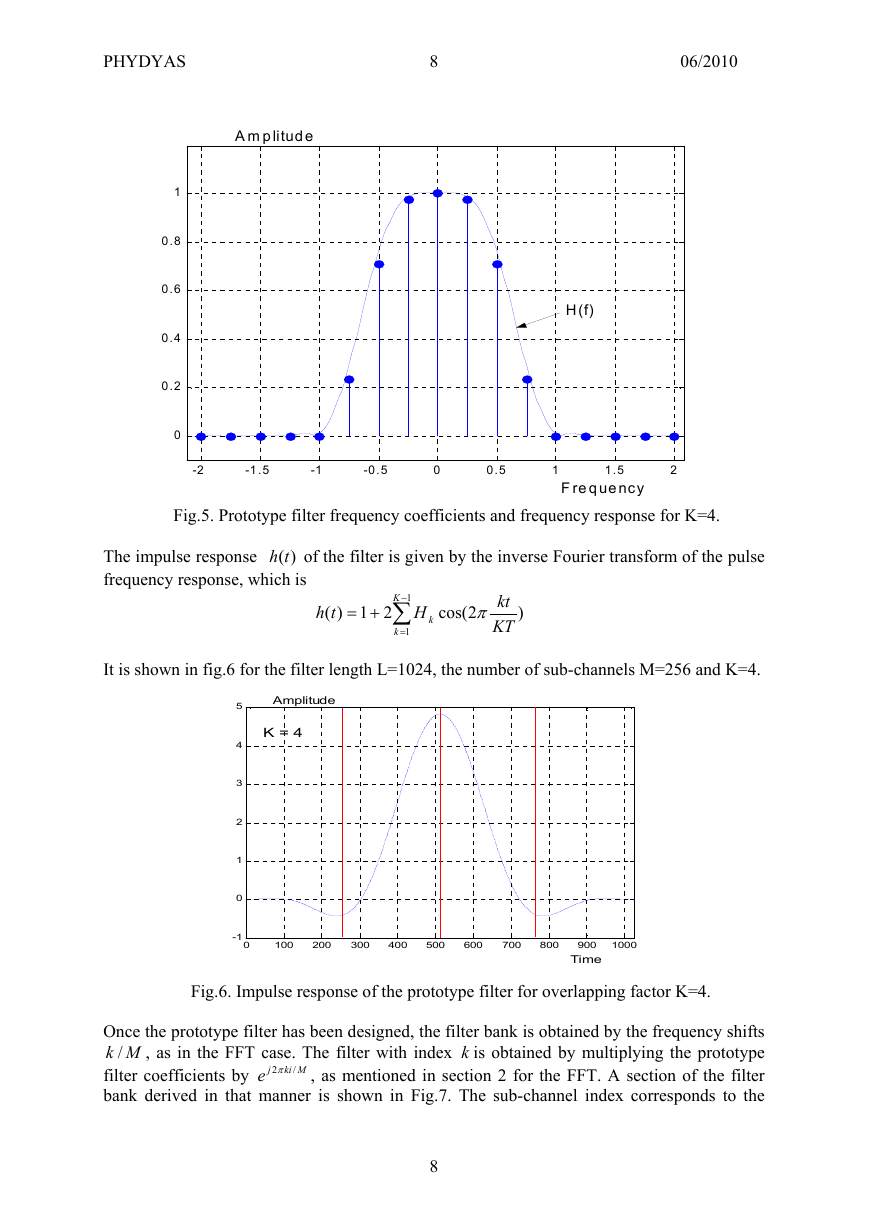








 2023年江西萍乡中考道德与法治真题及答案.doc
2023年江西萍乡中考道德与法治真题及答案.doc 2012年重庆南川中考生物真题及答案.doc
2012年重庆南川中考生物真题及答案.doc 2013年江西师范大学地理学综合及文艺理论基础考研真题.doc
2013年江西师范大学地理学综合及文艺理论基础考研真题.doc 2020年四川甘孜小升初语文真题及答案I卷.doc
2020年四川甘孜小升初语文真题及答案I卷.doc 2020年注册岩土工程师专业基础考试真题及答案.doc
2020年注册岩土工程师专业基础考试真题及答案.doc 2023-2024学年福建省厦门市九年级上学期数学月考试题及答案.doc
2023-2024学年福建省厦门市九年级上学期数学月考试题及答案.doc 2021-2022学年辽宁省沈阳市大东区九年级上学期语文期末试题及答案.doc
2021-2022学年辽宁省沈阳市大东区九年级上学期语文期末试题及答案.doc 2022-2023学年北京东城区初三第一学期物理期末试卷及答案.doc
2022-2023学年北京东城区初三第一学期物理期末试卷及答案.doc 2018上半年江西教师资格初中地理学科知识与教学能力真题及答案.doc
2018上半年江西教师资格初中地理学科知识与教学能力真题及答案.doc 2012年河北国家公务员申论考试真题及答案-省级.doc
2012年河北国家公务员申论考试真题及答案-省级.doc 2020-2021学年江苏省扬州市江都区邵樊片九年级上学期数学第一次质量检测试题及答案.doc
2020-2021学年江苏省扬州市江都区邵樊片九年级上学期数学第一次质量检测试题及答案.doc 2022下半年黑龙江教师资格证中学综合素质真题及答案.doc
2022下半年黑龙江教师资格证中学综合素质真题及答案.doc